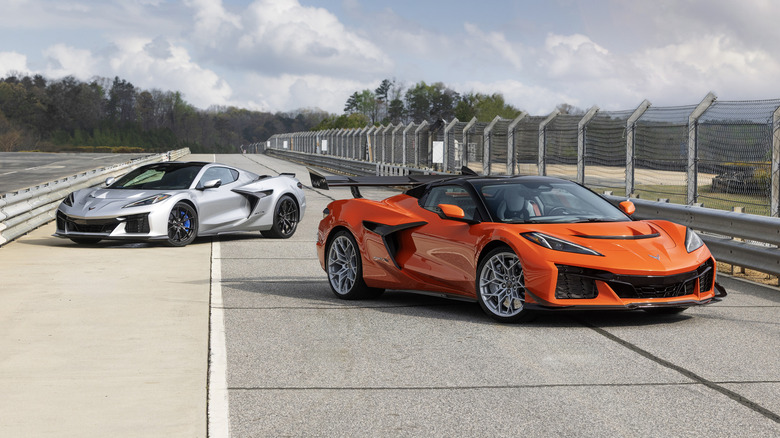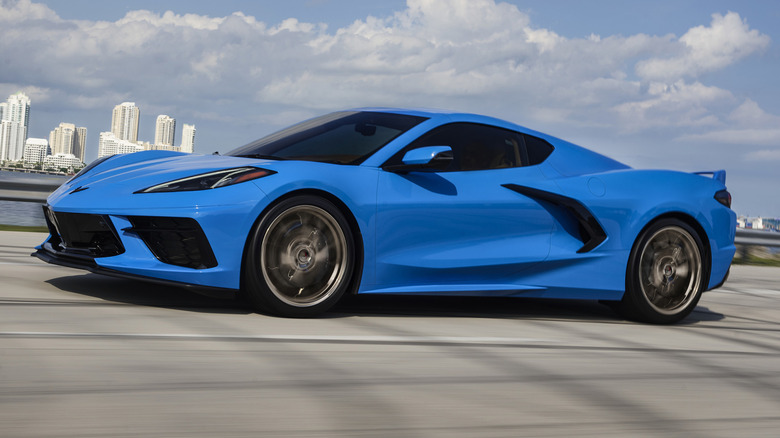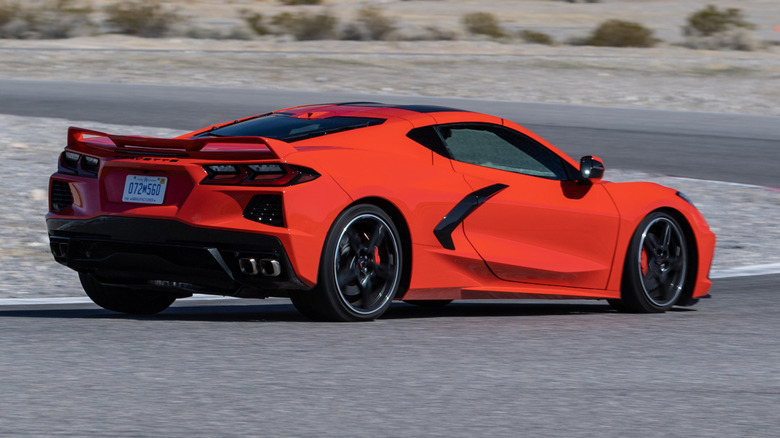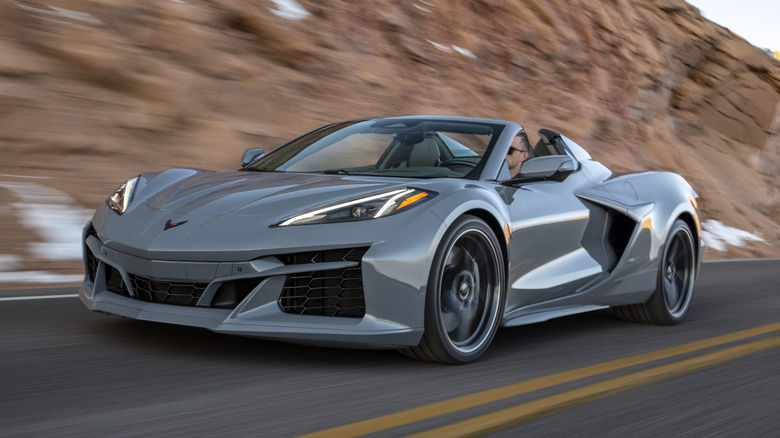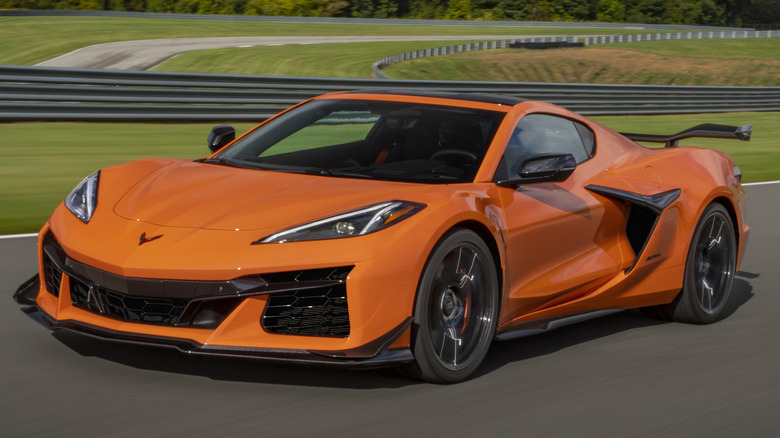Every Corvette C8 Model, Ranked By HP
When the eighth-generation Chevy Corvette debuted in 2020, it was arguably one of the most shocking moments in automotive history. Up to that point, every generation of the Corvette had the engine mounted in front of the driver. Now, after more than six decades of continuous production, the C8 Corvette was mid-engined. Chevrolet pointed to the advantages in weight distribution, responsiveness, and driver visibility with this all-new configuration.
Reading between the lines, it was also likely that the C7 Corvette in range-topping ZR1 spec had reached the limits of its performance potential with a big, heavy V8 in the nose. Making 755 horsepower, that ZR1 left big shoes to fill for the Corvette C8, as engine output has been one of the most important metrics since the Corvette first landed in the 1950s. Really, with 455 hp on tap in base Stingray trim, the seventh-gen Corvette was also part of the big-shoe conversation.
So, when the eighth-gen Corvette arrived with its 6.2-liter LT2 V8, it's fair to say critics and enthusiasts alike were frothing with excitement. Corvette firsts like dry-sump oiling and an eight-speed dual-clutch automatic transmission whetted that whistle, as did notes about the C8 Stingray being the most powerful entry-level Corvette ever. It was actually just the tip of the C8 iceberg as Chevrolet has been continually rolling out increasingly potent Corvette variants since. To illustrate this, here are all the current Corvette C8 models, ranked by horsepower.
Stingray: 490 HP
An increase of 35 horsepower over the outgoing C7 Stingray may not sound like much for the base C8 Corvette, but there's more to it than just numbers. The naturally aspirated 6.2-liter LT2 V8 found in the C8 Stingray has all-aluminum construction, a dry-sump oiling system, and direct fuel injection. Output measures 490 hp at 6,450 rpm and 465 lb-ft of torque at 5,150 rpm.
Chevy disappointed enthusiasts by dropping a manual transmission option with the C8, but one benefit of the eight-speed DCT is ultra-fast shift times. To keep that power controlled, the C8 Stingray rides on a four-corner double-wishbone suspension and staggered-width wheels that measure 11 inches wide in the rear. Brembo four-piston brake calipers clamp 12.6-inch front and 13.3-inch rear rotors to keep that power from getting out of hand. All of which combine to generate fairly staggering performance metrics. Zero to 60 mph takes just 2.8 seconds, and the Stingray is up to 150 mph in 19.4 seconds.
An 11.2-second quarter-mile at 122 mph is on tap, as is a 184-mph top speed, making it one of the fastest Corvettes ever made. Versus the base C7 Corvette with a manual transmission, the base Corvette C8 is faster in the all-important 60 mph run by more than a second. The benefits of a faster-shifting transmission help here, as does a weight reduction of 70 pounds, and of course, a healthy bump in horsepower.
Stingray with Performance Exhaust: 495 HP
Considering you can buy an aftermarket Paragon Performance exhaust system for the C8 Stingray that claims to add 14 horsepower, it may seem like buying an upgraded system from Chevrolet that only adds 5 horses isn't worth it. However, the factory performance system costs "just" $1,195, which is about $800 less than Paragon's system and as much as $4,000 less than other options on the market.
The Chevy performance exhaust also bumps torque output by 5 lb-ft, but for those looking to enjoy this factory output increase in conjunction with an increase in overall performance, there is the Corvette Z51 package. It costs $6,345, but along with the performance exhaust system, it brings a manually adjustable suspension system and electronically-controlled limited-slip differential. The rear axle ratio changes to 5.17, a third radiator is added for increased engine cooling, and Michelin Pilot Sport 4S summer tires are fitted.
Finally, brake cooling ducts are added, while the brake rotors increase in diameter by one inch up front and a half inch out back. Although the slightly higher output is unlikely to move the needle significantly in straight-line speed, the Corvette C8 with the full Z51 setup is capable of pulling 1.03 g on the skidpad and should sound even more aggressive than normal in the process.
E-Ray: 655 HP
Chevrolet rolled out the E-Ray Corvette C8 in 2024 and promptly turned the heritage of America's Sports Car upside down as this potent setup had a hybrid powertrain and all-wheel drive, both Corvette firsts. The E-Ray begins with the same 495-horsepower version of the V8 from the Stingray that drives the rear wheels through the eight-speed DCT. But it then adds a single electric motor up front to power the front wheels.
Fed by a 1.9-kWh battery pack, this motor makes 160 hp and 122 lb-ft of torque and has no physical connection to the ICE. In combination, the V8 and electric motor make 655 horsepower. Chevy notes this e-AWD system aids stability and enables true four-season driving capability. At the time of its release, the E-Ray was also the quickest production Corvette ever made. As in 2.5 seconds for the 60 mph sprint, 6 seconds flat to 100 mph, and a full 3 seconds faster to 150 mph than the Stingray.
This is all the more impressive considering the E-Ray is 408 pounds heavier than its Stingray stablemate. Other standard performance upgrades for this hybrid Corvette C8 include huge 13-inch wide rear rubber, carbon-ceramic brakes with 15.7-inch front rotors, and Magnetic Selective Ride Control dampers. And for when you need a bit of discretion from your 655-horsepower supercar, the E-Ray can be driven on electricity alone up to 45 mph in Stealth mode.
Z06: 670 HP
The increase of 15 horsepower from the E-Ray to the Z06 may seem unimpressive, but these are two very different C8 Corvettes. A big difference is that Chevrolet developed the Z06 on the same chassis as its C8.R race car. In other words, where the E-Ray is a boulevard blaster, the Z06 is a hardcore track weapon. Along with the special chassis, the Z06 is 3.6 inches wider than its brethren. This ensures that the rear wheels will fit within the wheel wells, which were the largest ever fitted to a production Vette when the Z06 arrived in 2023.
It also has six-piston Brembo front brake calipers, an adjustable rear spoiler, and available carbon fiber wheels. However, we are here for the Z06's high-revving V8. Dubbed LT6, this 5.5-liter mill is a dual overhead cam design, versus the LT2's pushrod setup. It has forged aluminum pistons and connecting rods, CNC-machined combustion chambers, titanium intake valves, and an active split intake manifold with twin 87 mm throttle bodies.
Perhaps the most exciting aspect is the flat-plane crankshaft design that enables an 8,600-rpm redline. That's a heady 1,900 rpm higher than what the LT2 V8 in Stingrays can manage and is a setup more commonly found in exotics from the likes of Ferrari. Making 670 hp at 8,400 rpm and 460 lb-ft of torque at 6,300 rpm, it was just one reason why the Corvette Z06 is such an expensive vehicle.
ZR1: 1064 HP
Chevy's long-running ZR1 nameplate is known as the king of the hill among Corvette enthusiasts, as it is typically the range-topping model for a given generation. For an iconic sports car like the Corvette, such a swaggering title requires big-time performance. For 2025, Chevrolet pulled out all the stops on its C8 ZR1. It started with the 5.5-liter LT2 V8 out of the Z06 that was heavily modified with unique head castings, a new valve train timing profile, a special intake system, secondary port fuel injection, and, oh yeah, a pair of turbochargers.
Due to the extensive changes, the ZR1's engine code is LT7, and according to Chevrolet, it makes an incredible 1,064 hp at 7,000 rpm and 828 lb-ft of torque at 6,000 rpm. As a reference point, that's 309 more horsepower than the aforementioned C7 ZR1.
Said to be the most powerful V8 ever made in America, the ZR1's LT7 can sling the king to 60 mph in 2.2 seconds, 100 mph in 4.5 seconds, 150 mph in under 10 seconds, through the quarter-mile in 9.5 seconds at 149 mph, and on to a top speed of 225 mph. One notable performance metric for the latest ZR1 is its ability to go from 80 to 200 to 80 mph in just 24.5 seconds, which is 22% faster than the prior ZR1. King of the hill indeed.
ZR1X: 1250 HP
Starting in 2026, there will be a new king in the neighborhood, the C8 Corvette ZR1X. Initially thought to be named the Corvette Zora, it blends the ZR1's 1,064-horse twin-turbo V8 with a more powerful version of the E-Ray's hybrid system. All told, the incoming ZR1X will be good for a fairly staggering 1,250 horsepower. Chevrolet rightly calls it America's hypercar.
With estimated performance highlights of 0 to 60 mph in under 2 seconds and a quarter-mile run in fewer than 9 seconds at more than 150 mph, that seems like a reasonable boast. Like the E-Ray, the ZR1X will not require any plugging in of the battery pack, as it will be charged via regenerative braking. But in the ZR1X, the motor fed by the battery makes an extra 26 horsepower and 20 lb-ft of torque. The latest high-powered C8 Corvette also comes standard with a special J59 braking package. It features an Alcon system consisting of 10-piston front and six-piston rear calipers with 16.5-inch carbon ceramic rotors at all four corners.
These are the largest brakes ever fitted to a production Corvette and deliver 1.9 g of deceleration force from 180 to 120 mph. Wow. Michelin Pilot Sport Cup 2 R tires will be optional, but are probably a good idea with that much performance on tap. And just like the rest of the Corvette C8 lineup, this most powerful of models is available as a coupe or convertible, for those who dare.
